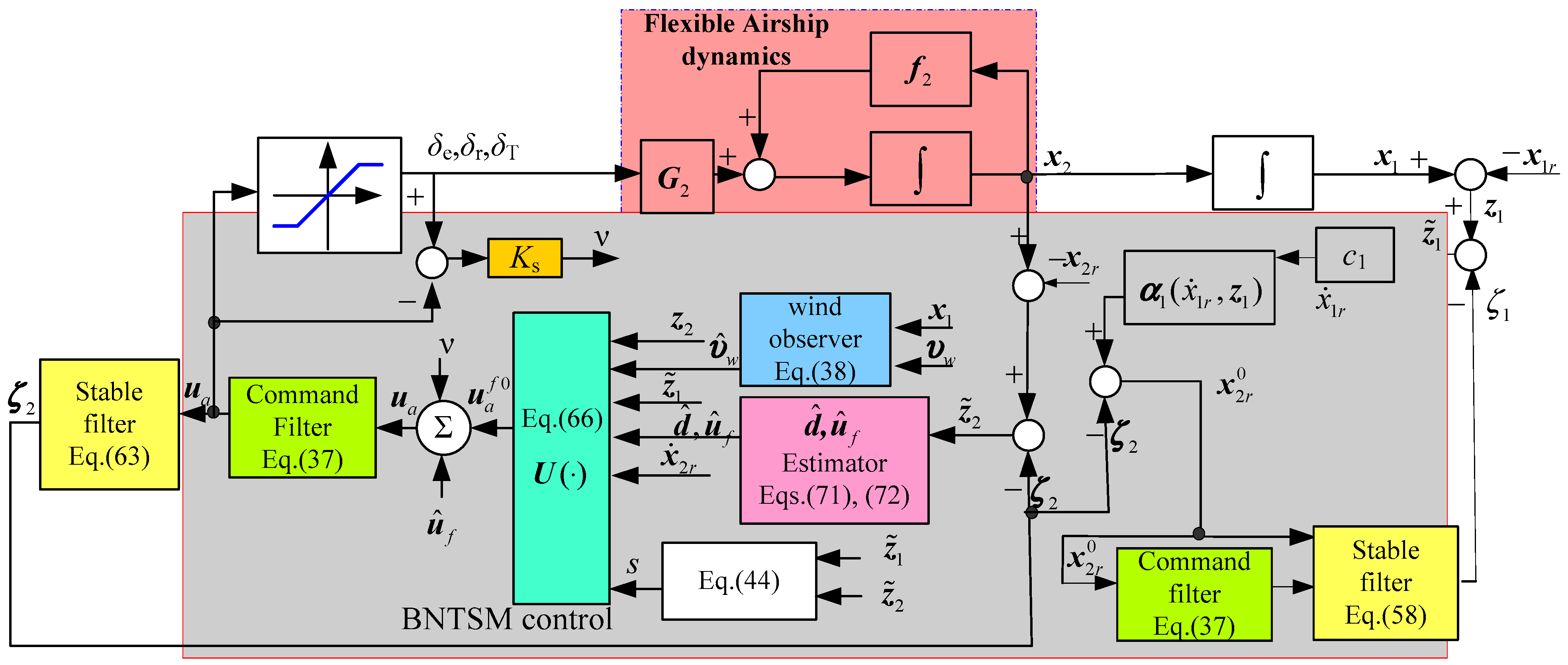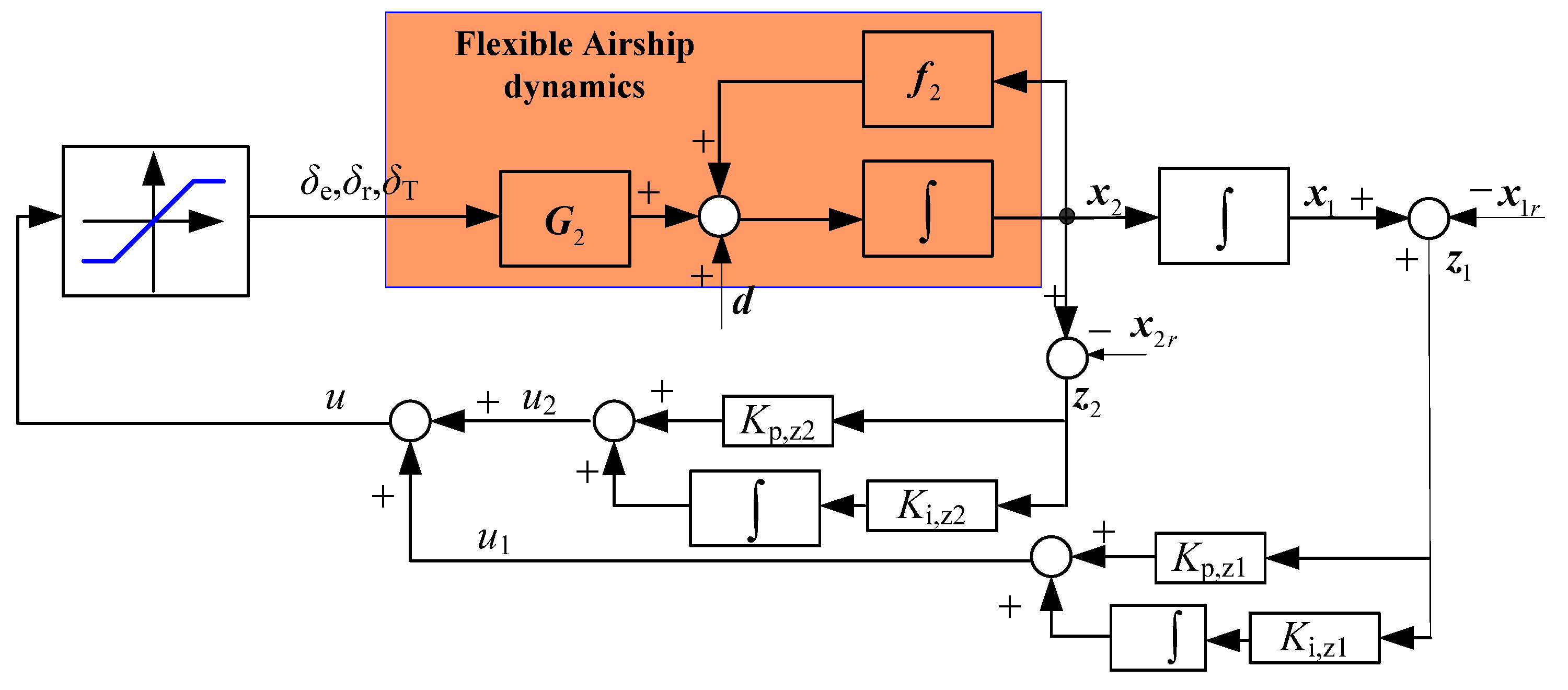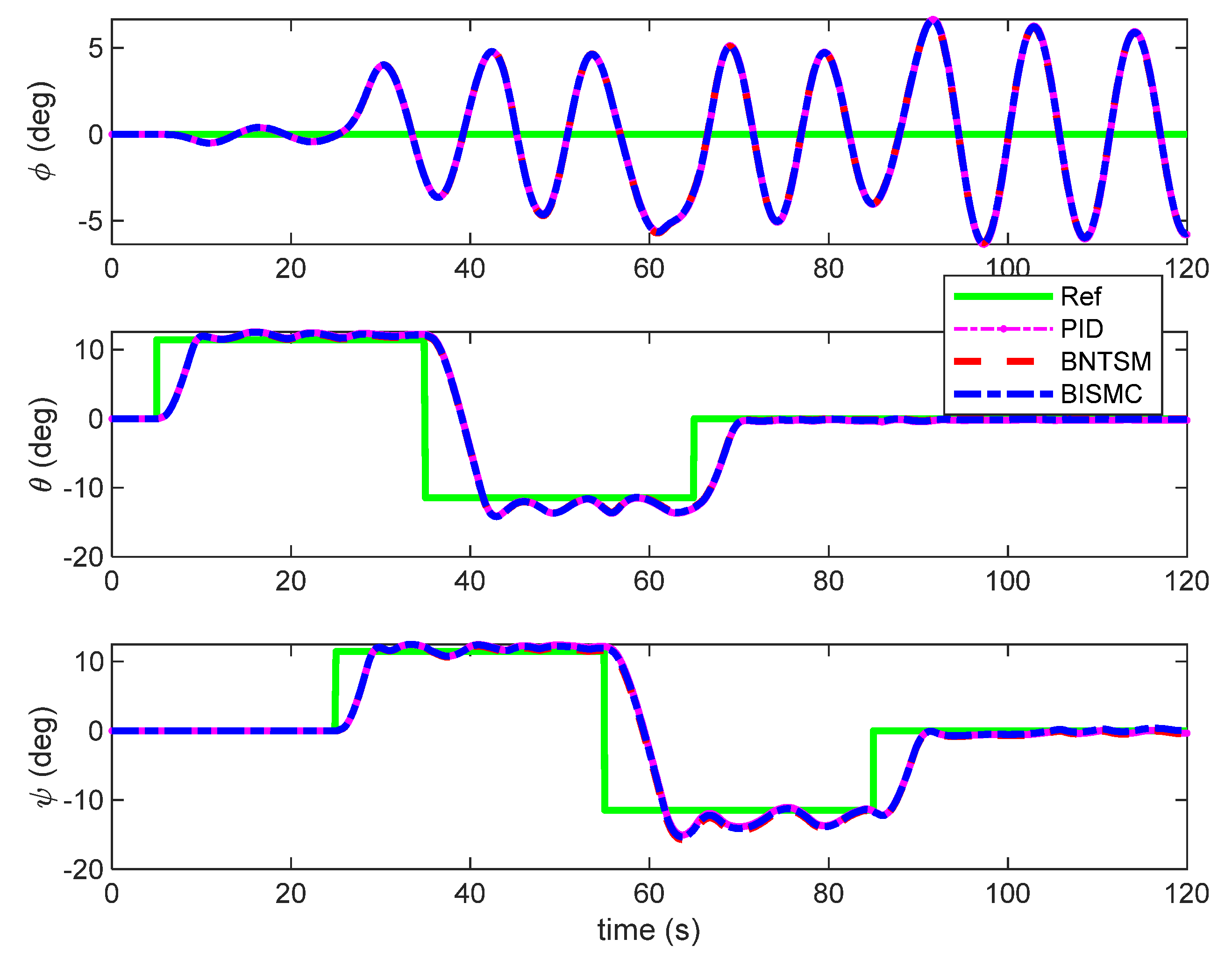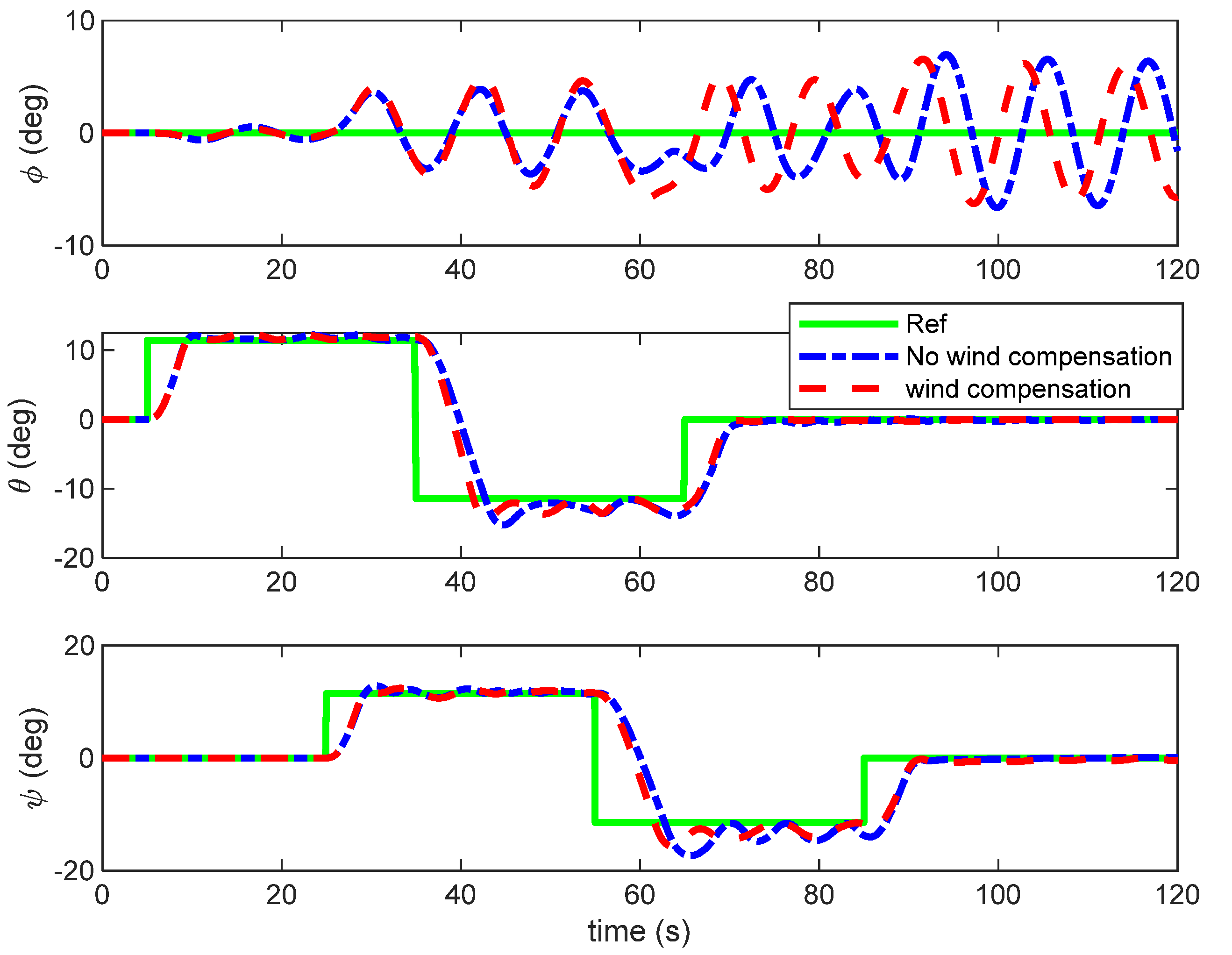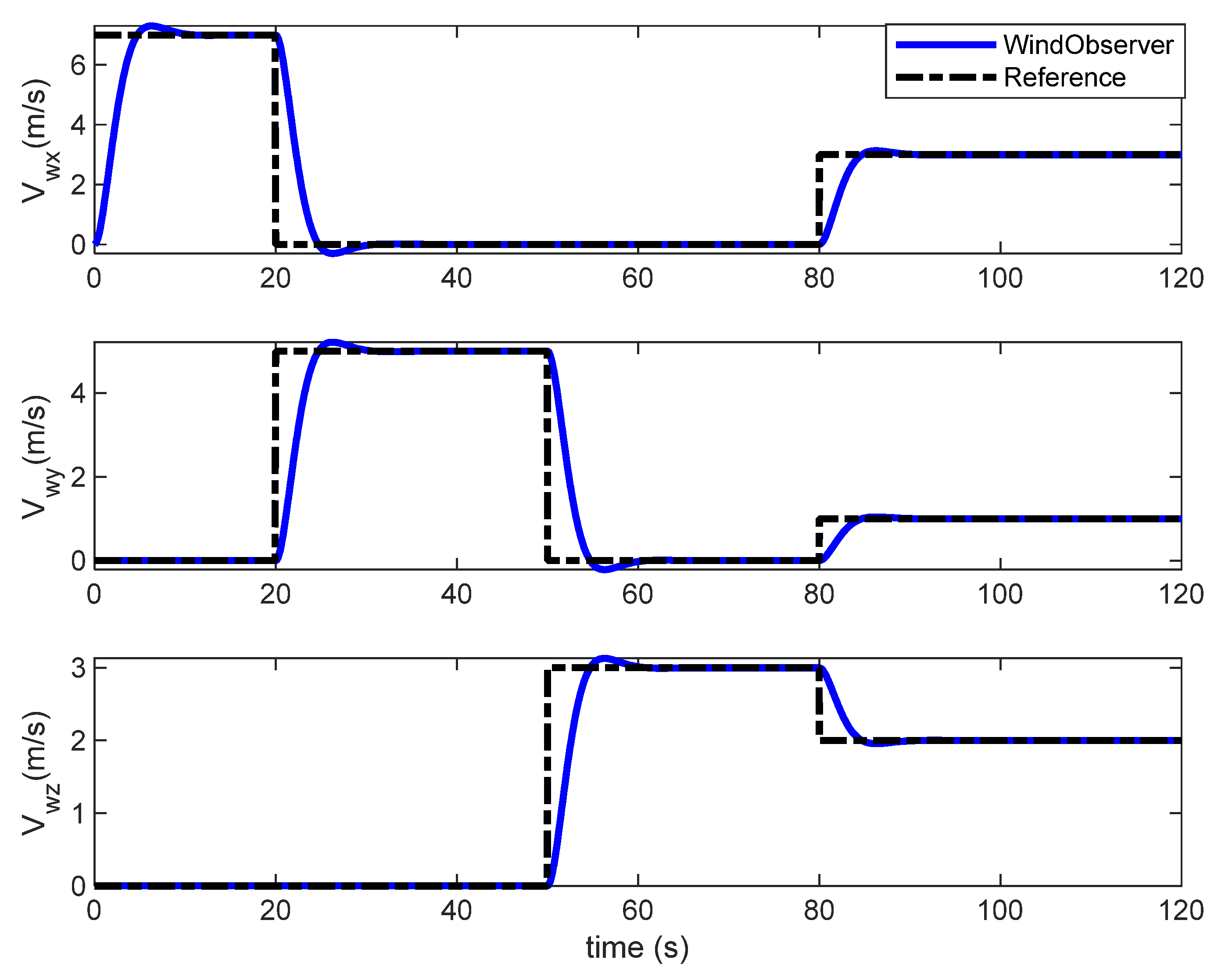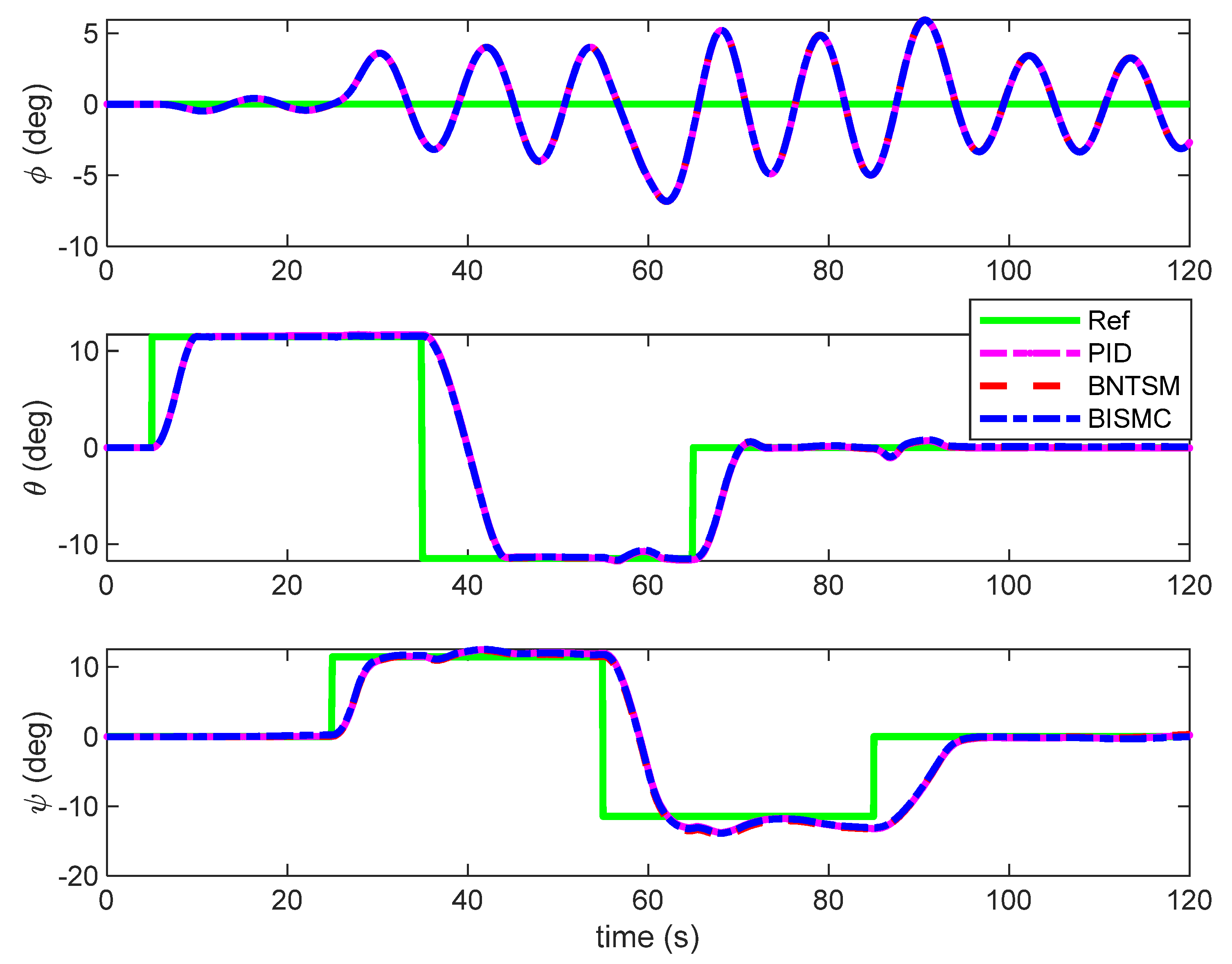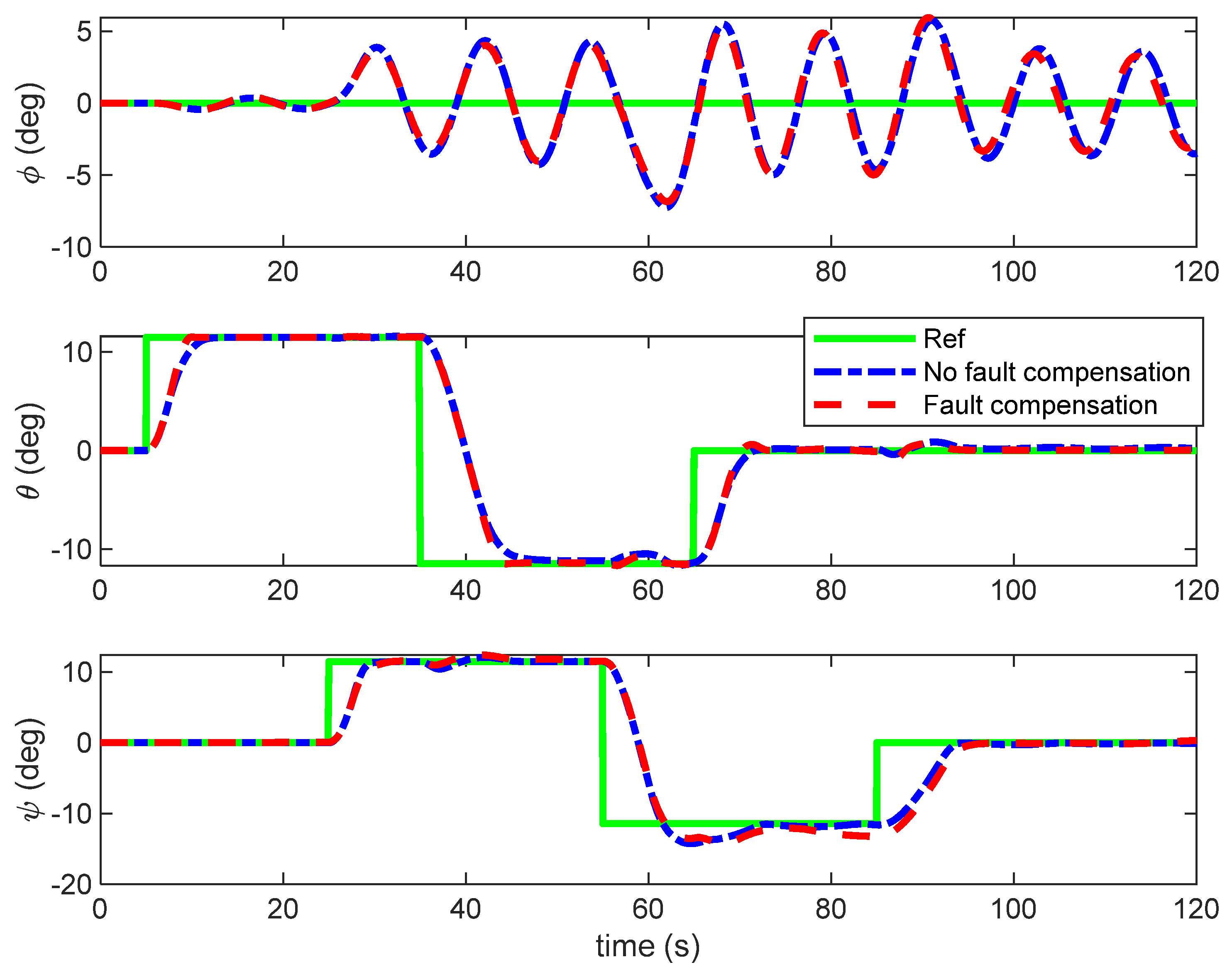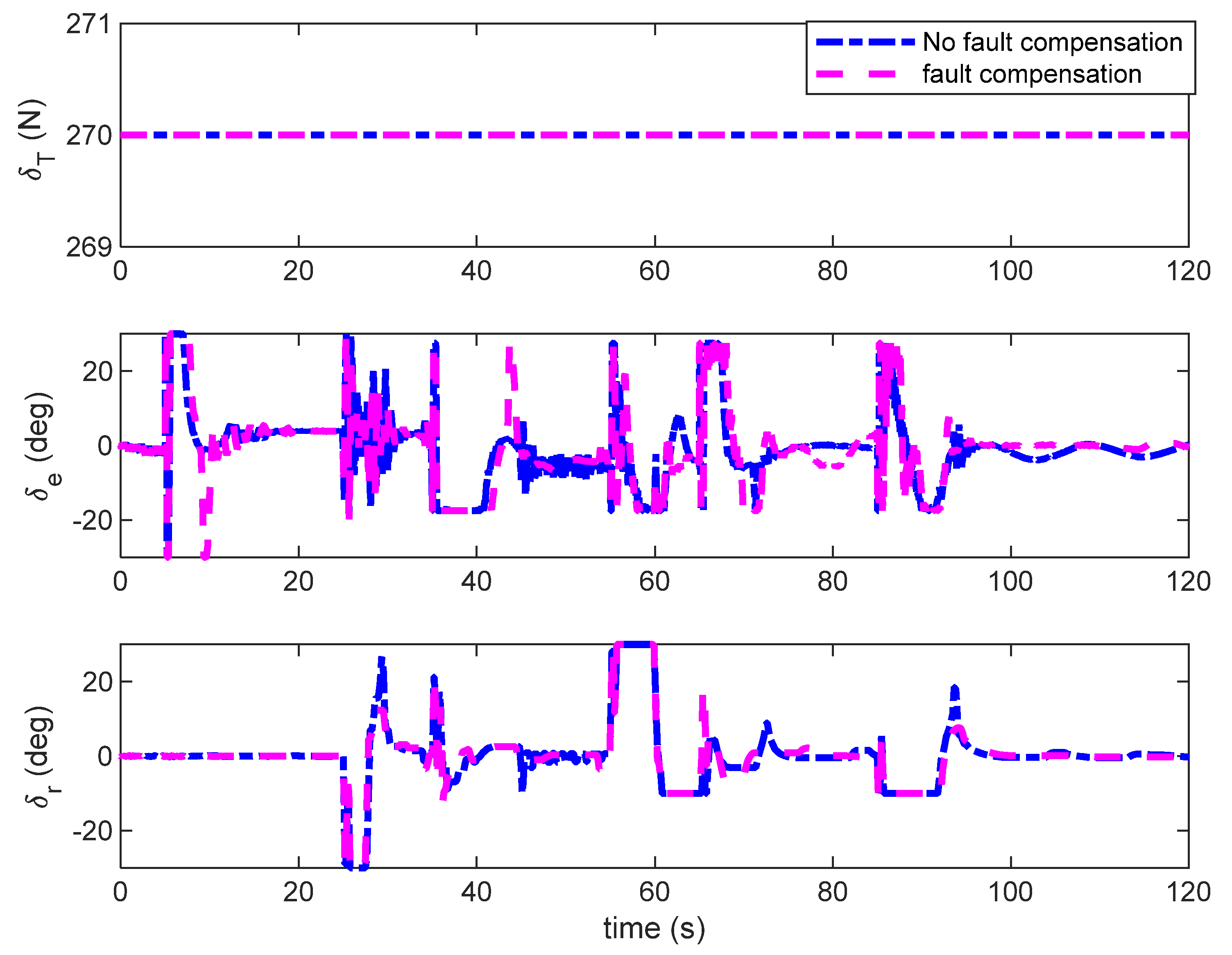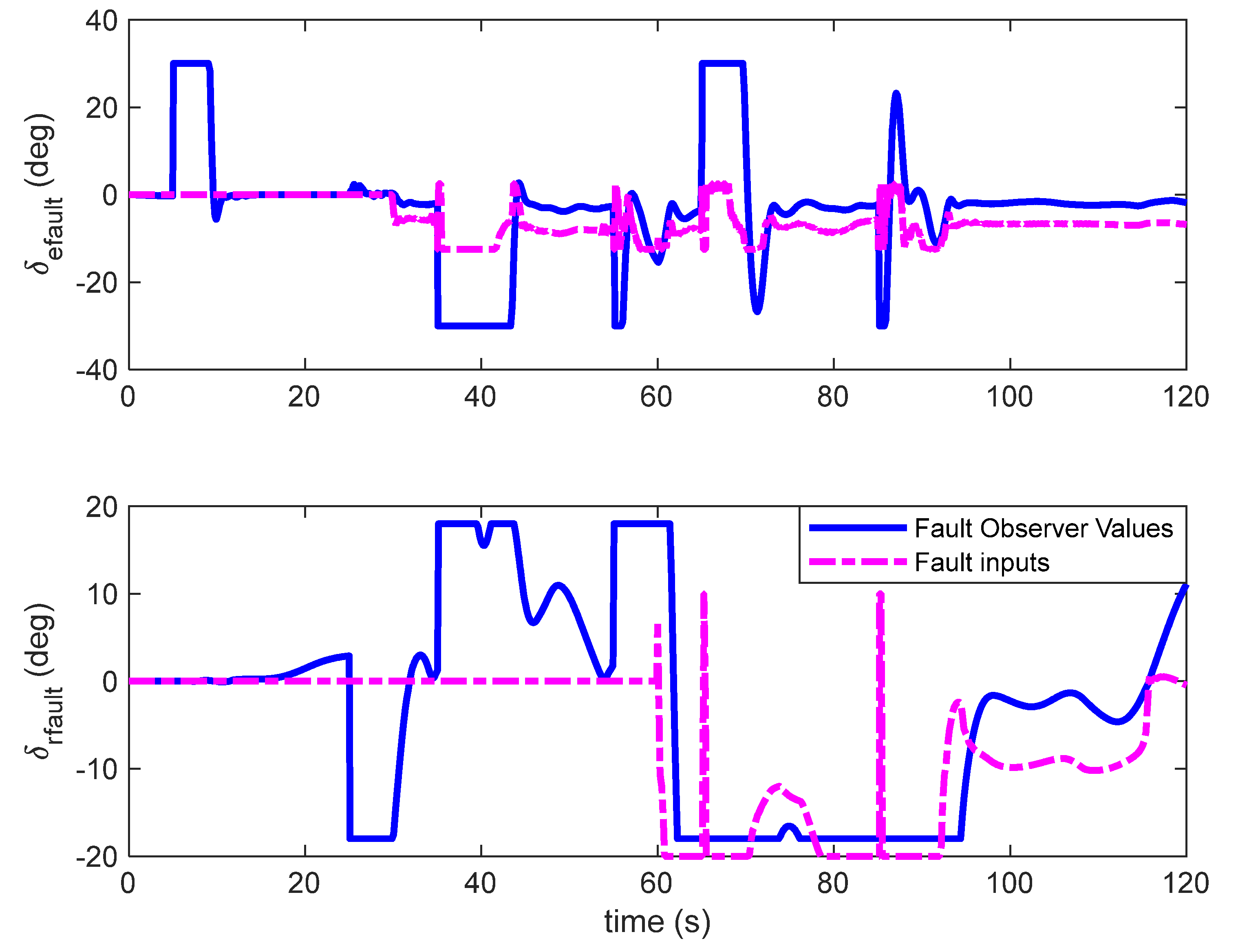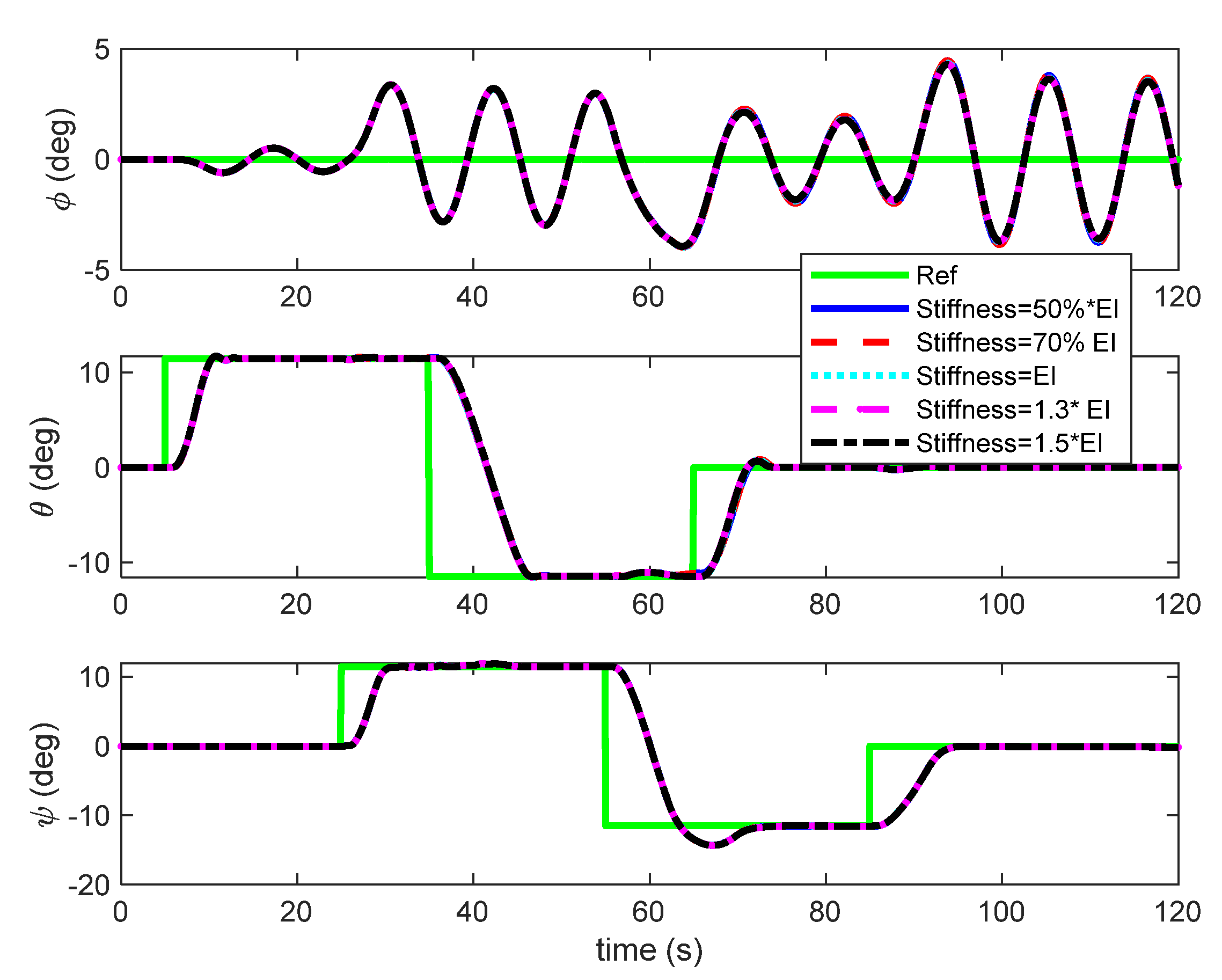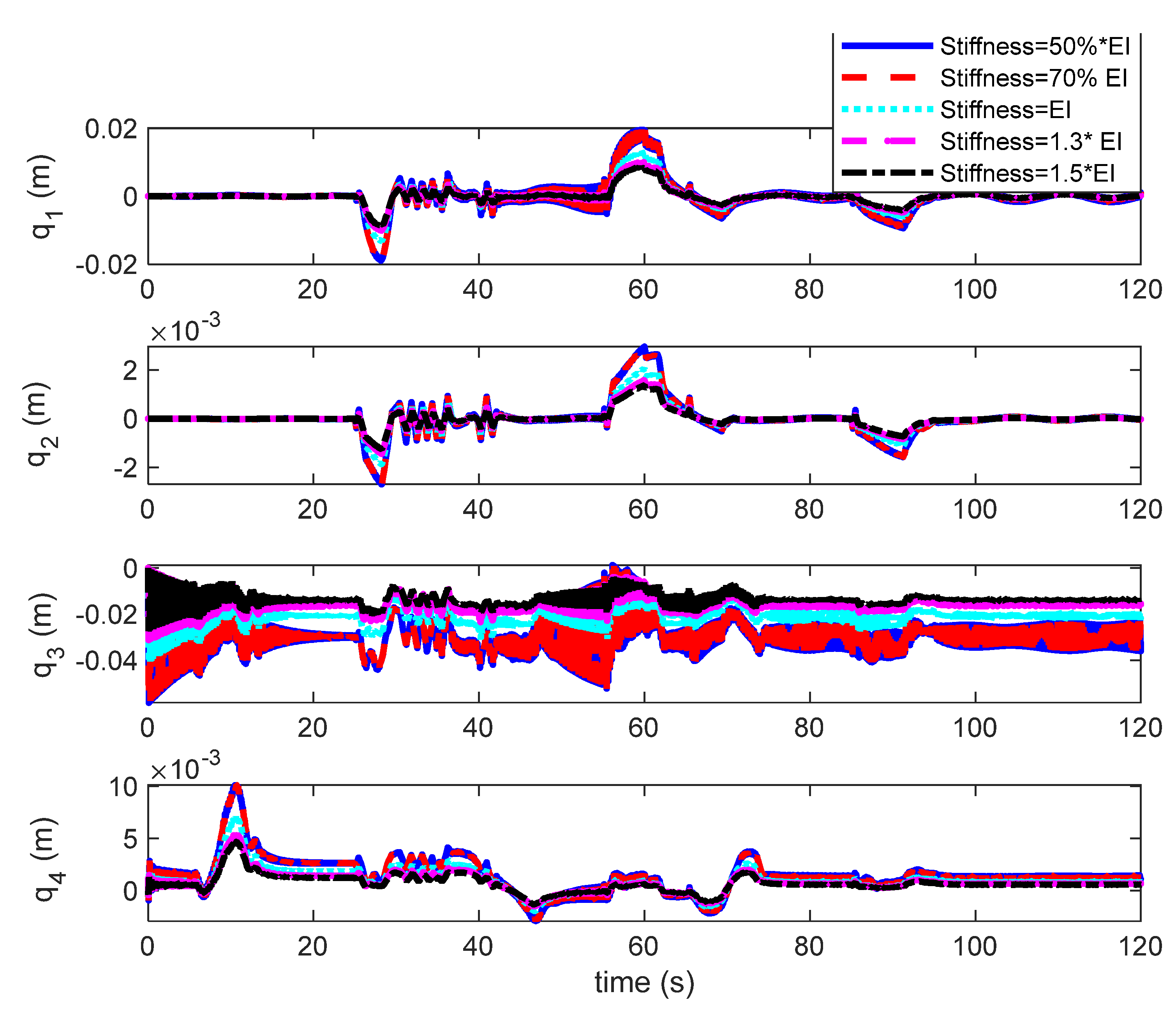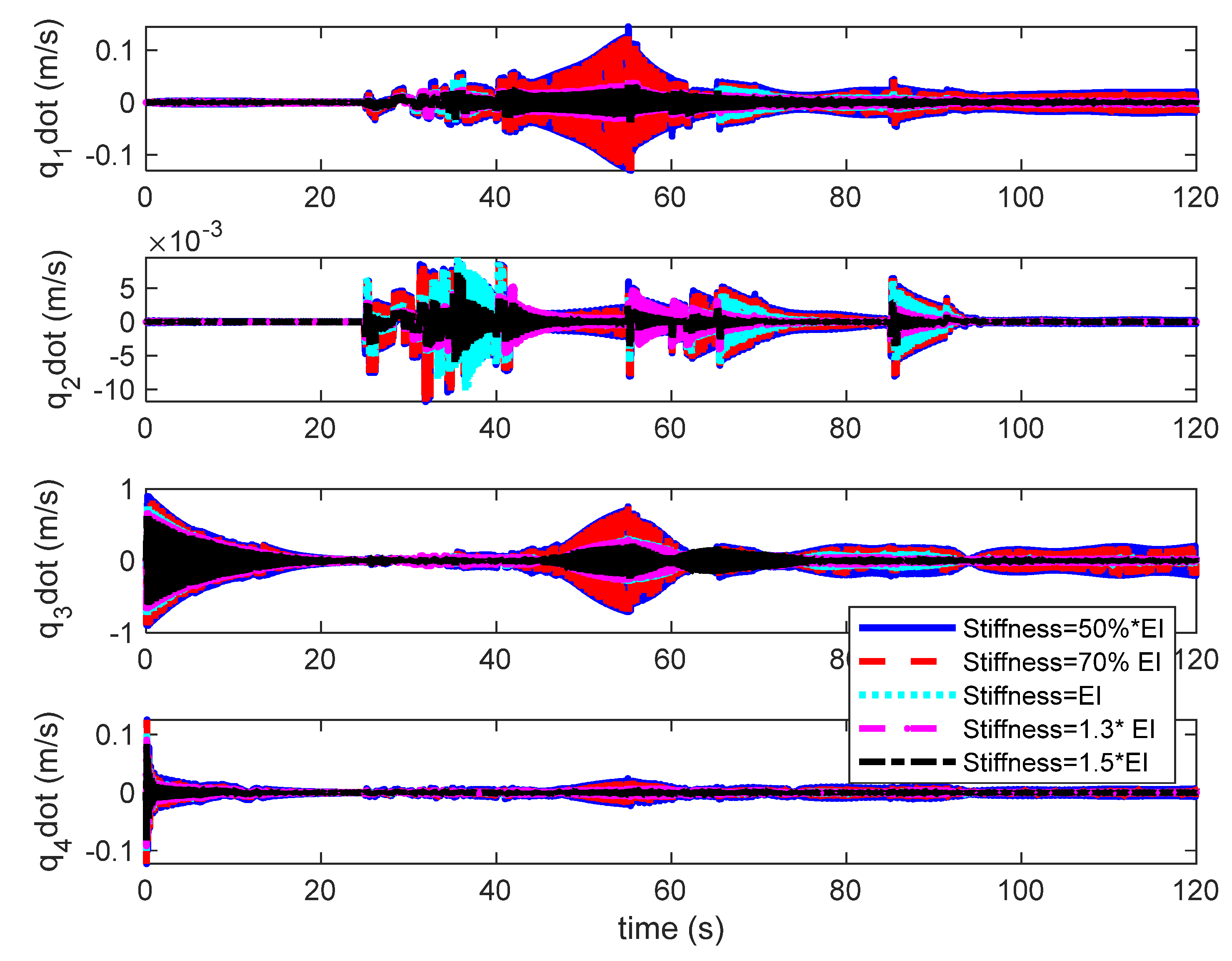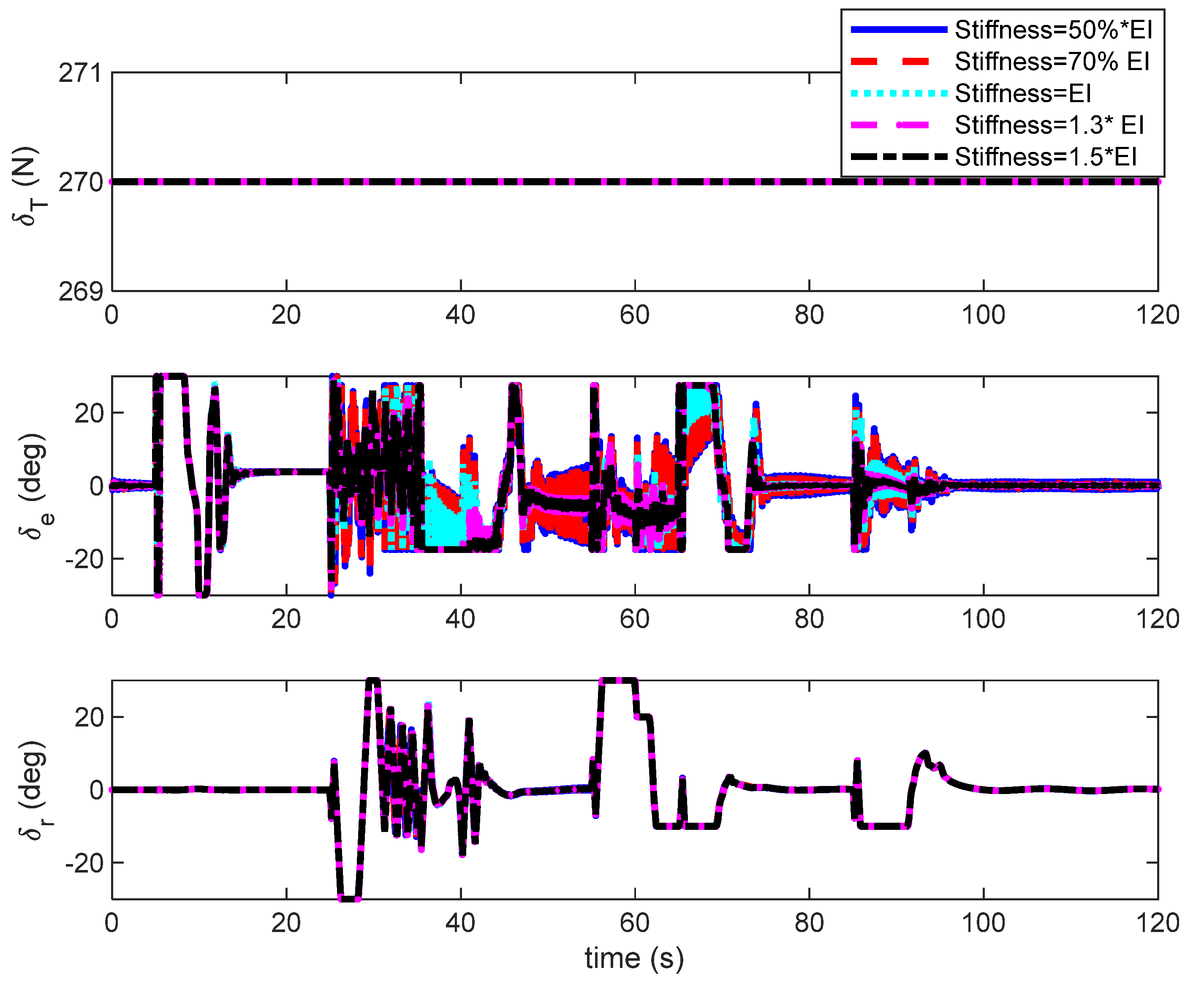2.1. Airship Kinematics Model
The equations of motion of a flexible airship are expressed in a body frame
Fb{Obxbybzb} fixed on the undeformed airship with its origin, O
b, at the center of volume (CV), see
Figure 1. The motion of the airship is described as the translation and rotation of this body frame with respect to the inertial frame
FI{OIxIyIzI}, plus the deformation of the material points on the body relative to the body frame [
21]. A centerline frame
Fp{Opxpypzp} is introduced to calculate the aerodynamics forces of the flexible airship. The elastic displacement
u of a material point on the airship can be written by a summation of the shape functions, as
where
are the time-dependent generalized coordinates,
are the structural mode shape vector, and
r is the position vector of the material point from the origin, O
b. The associated velocity distribution over the elastic body is:
where
= [
u,
v,
w]
T is the translational velocity vector in
Fb,
is the angular rate vector, and the × denotes cross-product operation. The first two terms of Equation (2) are related to the rigid body translation and rotation, while the last two terms reflect the influence of the elasticity on the local velocity.
Assume the airship is modeled as a free-free Euler–Bernoulli beam only undergoing bending deformation; hence, if the internal pressure is high enough to prevent wrinkling, then the hull bending can be described as the fundamental mode shape of the airship. The shape functions
are chosen as the natural vibration mode shapes of the beam, and 2
N shape functions are employed to describe the airship’s deflection, that is,
where
is the
ith natural mode shape of the free-free Euler–Bernoulli beam. The kinematics equations of the position and attitude of the airship are [
3]:
where
ξ = [
x,
y,
z]
T is the position vector,
is the attitude vector,
= [
u,
v,
w]
T is the translational velocity vector in
Fb, and
is the wind velocity in fixed frame. From Equation (4), it can be obtained that the local velocity is:
where
R(
η) denotes the direction cosine matrix [
3], and the transformation matrix
J is:
where
|θ| < π/2 is assumed to avoid the matrix singularity, and
s(·) and
c(·) denote sine and cosine functions, respectively.
The motions of the flexible airship are described as Lagrange equations [
24], and the flexible dynamics model is obtained as follows [
21]:
where
is the airship total mass, the virtual mass terms are included,
FI denotes the inertia force vector,
FG denotes the gravity vector,
FAS denotes the aerostatic force vector,
FAD denotes the aerodynamics force vector, and
FC denotes the control force vector;
and
denote the associated moments and general elastic forces of the flexible airship,
i =
I,
G,
AS,
AD and
C. The local velocity is as Equation (5);
denotes the generalized elastic coordinate vector.
denotes the internal elastic force vector,
where the stiffness matrix
K meets
where
.
EI denotes bending stiffness with
EI = π
R3 ET0,
E is the elastic modulus of the hull envelope,
T0 is its thickness, and
R is the hull radius. Equation (7) can be rewritten as
where
is the augmented state vector,
denote control inputs of the thruster, elevator, and rudder, and
where (
xT,
yT,
zT) and (
xr,
yr,
zr) denote positions of the thrust and control surface in the body frame,
Fb, respectively;
xm is the position of the aerostatic center along the x-axis,
kT is control gain for thruster.
and
denote the aerodynamic derivative coefficients of the elevator and rudder, respectively,
denotes the dynamic pressure,
V is the airspeed, and
ρ is the air density.
Next, we detailed and present each force and moment on the right-hand side of Equation (11). The inertia force and moment vector of the flexible airship in Equation (11) is [
21]:
where
The superscript denotes the skew-symmetric matrix form of a vector (corresponding to a cross-product operation). Consider the gravity, aerostatic force, and moment vector of the flexible airship in Equation (11). Gravity, the resulted moment, and its generalized one are described as follows:
where
g denotes that the acceleration of gravity and unit direction vector of gravity is:
The aerostatic force in the body frame in Equation (11) is:
The resulted moment and its generalized moment are presented as follows:
where
VB denotes the volume of the airship hull and
S is the hull cross-sectional area:
The aerodynamics force and moment vector of the flexible airship in Equation (11) is:
where subscripts p, v, F, H(F), and the axial on the right-hand side of Equation (27) denote the forces and moments due to the potential-flow (related to the added mass), viscous effect on the hull, aerodynamic force acting on fins and acting on the hull due to the fins, and axial drag, respectively. The calculation of the aerodynamics forces is the same as in [
21].
The control force and moment vector
of the flexible airship includes those of propellers and control surface deflections. The thrust in the body frame is
; the corresponding moment and generalized moment are as follows:
where
is the mode shape function at the propeller-mounted position
. Forces due to the control surface deflection are presented in the body frame, as
where
denotes the area of control surface, and
and
are the lift and drag resulted from the control surface deflection. The corresponding moment and generalized moment are:
where
is the shape function at the control surface-mounted position of
.
Considering the model uncertainties or disturbances often occurring in the dynamics system of Equation (10), assume the atmospheric parameters are stable and disturbances are bounded; thus, a model uncertainty,
d, and the actuator saturation are introduced, thus the system (10) can be modified, as
where
d denotes disturbances except for winds and model uncertainties, such as aerodynamic coefficients and structural stiffness;
denotes saturation function. As the airship has a large inertia and its motion is slow and sedate,
d can be assumed to be a slow-varying disturbance, which can be estimated on-line by using an adaptive law. Let
be the estimated value of the uncertain parameter
d;
is the associated estimated error. Finally,
Г denotes the disturbance coefficient matrix. The faults can be modeled as abrupt changes of the nominal control action from
[
26,
27],
that is,
where
is the actual control output; the diagonal matrix
denotes the operational effectiveness of the actuators;
I is the
m×
m identity matrix; the fault vector
denotes the control action from the failed or un-manipulated actuators;
denotes the remaining control of the health actuators;
denotes the fault of the inputs.
Assumption 1. In Equation (34), for the multiplicative and additive actuator faults,andare all bounded. In addition,andexist and are bounded, i = 1, 2, …, m.
Substituting Equation (35) into Equation (33) yields:
Remark 1. There are two underactuated cases for the flexible airship. Case 1. The airship without a lateral tilt angle of the propellers (i.e., the thrust direction is fixed) is underactuated in the y-direction (that is, the lateral control force, Tsy = 0); thus, the sway velocity, v, cannot be directly controlled. If the wind is in the presence in this case, then the airship can align against the wind through the yaw motion, reducing the lateral forces requirement to a low and acceptable value; thus, the lateral force input can vanish in stationary conditions. Case 2. The airship works in Case 1 without ailerons or differential actuators (i.e., δeL = δeR, δrU = δrB, and the roll control moment, MTx ≈ 0). Sway velocity, v, and bank angle, φ, cannot be directly controlled. In this case, the disturbance of the roll moment resulting from the wind can be attenuated by the airship roll damp; thus, the roll moment input can vanish in stationary conditions.

